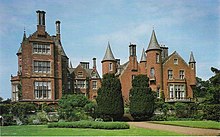Tyninghame House
Tyninghame House is a mansion near the Scottish hamlet of Tyninghame in the East Lothian Council Area . In 1971 the building was included in the Scottish Monuments List in the highest category A. In addition, the associated sundial is classified separately as a Category A structure. Various exterior buildings are classified as Category B or Category C structures. All individual monuments are also combined to form a category A monument ensemble. Most recently, the surrounding parks are listed in the Scottish Landscape Gardens Register.
history
Tyninghame is one of the oldest Anglo-Saxon settlements in Scotland. It can be traced back to the 7th century. In the middle of the 8th century the monk Baldred of Tyninghame lived there and established a Christian location in Scotland, which developed into an important monastery. The surviving fragments of St Baldred's Church on the grounds of today's Tyninghame House testify to this . From 1094 a country house of the monks of St Cuthbert is listed on the site, to whom King Duncan II made the land available in the same year. By 1250 at the latest, it was owned by the Bishops of St Andrews , who used the property as a summer residence. In the 16th century, the Lauders of The Bass leased Tyninghame. In the summer they lived at their ancestral home on Bass Rock and in the winter months in Tyninghame. In the course of the Scottish Reformation and the associated secularization of ecclesiastical properties, the Lauders acquired the property.
After several changes of ownership, Thomas Hamilton, 1st Earl of Haddington Tyninghame in 1628. On the basis of the existing building, he had the first mansion built on this site, which served as the ancestral home of the Earls of Haddington . After the marriage between Charles Hamilton, 5th Earl of Haddington and the daughter of the Dukes of Rothes in the late 17th century, the latter spent most of the time on their estate in Rothes . When his heir Thomas Hamilton, 6th Earl of Haddington, returned to Tyninghame House around 1700, he found it in a neglected state. Together with his wife, he is particularly responsible for the layout of the parks and gardens. Thomas Hamilton, 9th Earl of Haddington hired the well-known Scottish architect William Burn to redesign and expand the mansion in 1828 . In this last significant construction phase, Tyninghame House received its current character.
With the death of George Baillie-Hamilton, 12th Earl of Haddington , Tyninghame House was sold. Large parts of the interior furnishings were auctioned off in an auction at the location under the direction of the auction house Sotheby’s . To counter a breakup, the National Library of Scotland acquired the 345 volumes of political and legal records from Thomas Hamilton, 1st Earl of Haddington. In the following period the mansion was rebuilt and divided into separate residential units. John George Baillie-Hamilton, 13th Earl of Haddington now lives at Mellerstain House in the Scottish Borders .
description
The complex, Scottish Baronial style mansion is located around one kilometer northeast of Tyninghame. The Tyne , which runs 300 m south, limits the property and flows a short distance east into the North Sea . The masonry of the two- to three-storey building with its various towers, Ecktourellen and stepped gables is made of red sandstone , which was roughly trimmed into cuboids. Details are set off with red or gray sandstone. The entrance area was redesigned in 1961 by Schomberg Scott .
sundial
The sundial forms the center of the Italian garden laid out by William Burn in the late 1820s on the west side of Tyninghame House. In its essential aspects, it is a replica of the sundial of Newbattle Abbey in Midlothian . It rests on a stepped octagonal foundation with a fluted pedestal. The building, designed as a needle-shaped obelisk , is richly ornamented and adorned with figures of the sphinx .
Individual evidence
- ↑ a b Listed Building - Entry . In: Historic Scotland .
- ↑ a b Listed Building - Entry . In: Historic Scotland .
- ↑ a b c Garden and Designed Landscape - entry . In: Historic Scotland .
- ↑ a b Entry on Tyninghame House in Canmore, the database of Historic Environment Scotland (English)
- ^ Entry in the Gazetteer for Scotland
- ↑ Entry on Sundial of Tyninghame House in Canmore, the database of Historic Environment Scotland (English)
Web links
- Entry on Tyninghame House in Canmore, Historic Environment Scotland database
- Entry in the Gazetteer for Scotland
Coordinates: 56 ° 0 ′ 35.9 " N , 2 ° 36 ′ 43.3" W.
